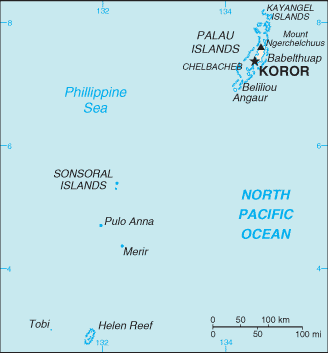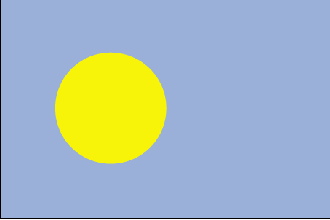
|
Palau
Background:
After three decades as part of the UN Trust Territory of the Pacific under US
administration, this westernmost cluster of the Caroline Islands opted for
independence in 1978 rather than join the Federated States of Micronesia. A
Compact of Free Association with the US was approved in 1986, but not ratified
until 1993. It entered into force the following year, when the islands gained
independence.
Location:
Location: Oceania, group of islands in the North Pacific Ocean, southeast of
the Philippines.
Area: Total: 458 sq km.
Area - comparative: Slightly more than 2.5 times the size of Washington, DC.
Coastline: 1,519 km.
Climate and Terrain:
Climate: Wet season May to November; hot and humid.
Terrain: Varying geologically from the high, mountainous main island of
Babelthuap to low, coral islands usually fringed by large barrier reefs.
deep-seabed minerals.
Geography - note: Westernmost archipelago in the Caroline chain, consists of
six island groups totaling more than 300 islands; includes World War II
battleground of Beliliou (Peleliu) and world-famous rock islands.
People:
Population: 19,717.
Ethnic groups: Palauan (Micronesian with Malayan and Melanesian admixtures)
70%, Asian (mainly Filipinos, followed by Chinese, Taiwanese, and Vietnamese)
28%, white 2%.
Religions: Christian (Roman Catholics 49%, Seventh-Day Adventists, Jehovah's
Witnesses, the Assembly of God, the Liebenzell Mission, and Latter-Day Saints),
Modekngei religion (one-third of the population observes this religion, which
is indigenous to Palau).
Languages: English and Palauan official in all states except Sonsoral
(Sonsoralese and English are official), Tobi (Tobi and English are official),
and Angaur (Angaur, Japanese, and English are official).
Government:
Government type: Constitutional government in free association with the US; the
Compact of Free Association entered into force 1 October 1994.
Capital: Koror.
Independence: 1 October 1994 (from the US-administered UN Trusteeship).
Economy overview:
The economy consists primarily of tourism, subsistence agriculture and fishing.
The government is the major employer of the work force, relying heavily on
financial assistance from the US. Business and tourist arrivals numbered 50,000
in FY00/01. The population enjoys a per capita income twice that of the
Philippines and much of Micronesia. Long-run prospects for the key tourist
sector have been greatly bolstered by the expansion of air travel in the
Pacific, the rising prosperity of leading East Asian countries, and the
willingness of foreigners to finance infrastructure development.
Statistics:
Telephones - main lines in use: 6,700.
Telephones - mobile cellular: 1,000.
Radio broadcast stations: AM 1, FM 4, shortwave 1.
Radios: 12,000.
Television broadcast stations: 1.
Televisions: 11,000 (1997)
Railways: 0 km
Highways: Total: 61 km, paved: 36 km, unpaved: 25 km.
Airports - with paved runways: 1, with unpaved runways: 2.
Return to Visiting Locations
|

